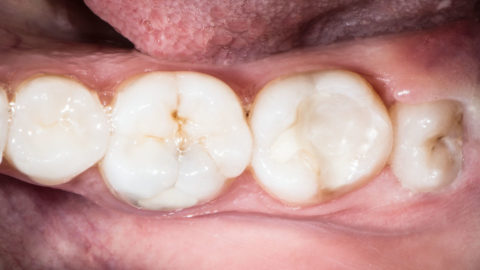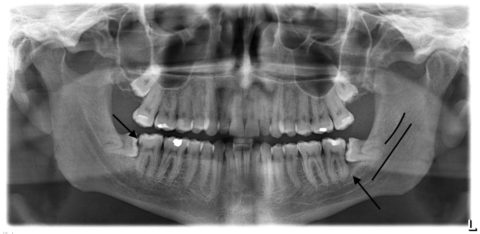These are unprecedented times. I’m not going anywhere with that statement; I just think that in these unprecedented times, we all need to make a point to say it every chance we get, just like they do in all the commercials.
Which leads us to the topic at hand – wisdom teeth. For most of us, once we reached the mid- to late teenage years and just when our zits were starting to clear up, we were told by our dentist that it was “time to have your wisdom teeth out.” Although we probably just sat there nodding obediently, inside we were asking “Why do I have to have my wisdom teeth out? They aren’t hurting anything.” But the following summer we dutifully acquiesced and had them out. It was a rite of passage.
Wisdom teeth and tonsils used to have a lot in common, not the least significant of which was the attitude by dentists and physicians that if they were in your head, they needed to come out no matter what. Like the old adage “don’t ask a barber if you need a haircut,” it was common knowledge that if you asked an oral surgeon if you needed your third molars out, the answer was a predetermined affirmative.
Nowadays, the research is showing that wisdom teeth may not have to be summarily extracted; indeed, some may be maintained in a healthy state throughout one’s life. After all, just as with any medical procedure, there are risks as well as benefits associated with third molar removal, and these must be carefully weighed in deciding what the best course of action should be. There are a lot of moving parts here, and I’ll try not to get too bogged down with minutiae, but let’s visit the wonderful world of wisdom teeth, shall we? My goal is not to make you an expert on third molar pathosis and treatments, but to give you the tools necessary to make an informed choice for yourself or family member if the need arises.
Very brief fundamentals
The “normal” human mouth contains 32 permanent teeth: 8 incisors in the front, 4 canine teeth (aka “eye teeth”) behind the incisors, 8 premolars (or bicuspids), and 12 molars. The first and second molars are usually referred to as the “6 year molars” and “12 year molars,” respectively, and the average ages of eruption should be apparent by those nicknames. The eruption schedule for wisdom teeth is more variable; typically they erupt between ages 17 and 21, but can come in significantly earlier or later than this. However, unlike their 28 predecessors, by the time the wisdom teeth erupt there often isn’t enough room for them to come in normally, which can cause the issues for which they are famous. Humans living before 10,000 years ago, as well as many contemporary indigenous people, had (and have) plenty of room for all 32 teeth, in contrast to today. There are many interesting hypotheses for why this has happened, but that discussion is for another day. If you’re interested in going down that wormhole, you can read a couple of fine articles here and here.
A fortunate minority of people today will have enough room for their wisdom teeth to erupt normally, but for just about everyone else, lack of space and other factors can cause a number of issues ranging from mildly annoying to very serious and painful to even life threatening in rare cases. What are these potential problems, you may ask?
Potential problems
Space will not permit me to list all of the possible diseases associated with third molars, so I will focus on the three most prevalent issues we see in the dental office that leads to wisdom tooth removal – pericoronitis, caries (i.e. tooth decay) and related disease, and caries on the distal (backside) of the adjacent second molar. Please note that almost all of the problems associated with wisdom teeth occur in the lower jaw, and I have and will refer to the operators who remove said teeth as oral surgeons, the dental specialists who handle these sorts of things, but be aware that many general dentists also extract third molars.
 Fig. 1
Fig. 1
- Pericoronitis – Pericoronitis (“peri-” = around, “coron-” = the crown of the tooth, “-itis” = inflammation) is inflammation around a partially erupted tooth (See Fig. 1). When a tooth isn’t fully erupted, a flap of tissue lies atop the crown (or top) of the tooth. Bacteria, food debris, and other bugaboos can get under this flap, where it is almost impossible to adequately clean. This can lead to swelling, pain, bone loss, and infection (abscess).
- Caries and related disease – Even in the rare instance where a wisdom tooth comes in straight and perfect, it’s still difficult to reach with a toothbrush, floss, and other cleaning aids. Consequently, it is more susceptible to tooth decay and associated problems, such as pulp (nerve) inflammation or necrosis, which could result in a dental abscess.

Fig. 2
Caries on the distal of the adjacent second molar. Because of the aforementioned difficulty in keeping the area around third molars clean, tooth decay can also form on the tooth in front of the wisdom tooth, especially if the wisdom tooth is impacted. In Fig. 2, on your left (the patient’s right), you can see where a cavity (dark shadow) is starting (arrow) on the 2nd molar due to the presence of the impacted third molar. On the other side, the angular impaction has caused severe bone loss on the distal (backside) of the second molar (other arrow). Even after the wisdom tooth is removed, there is a significant chance that the patient will lose the second molar as well. As an aside, even though the upper wisdom teeth are unerupted, because of the shape of the upper jaw and the angulation of the teeth, they are unlikely to cause a problem.
Obviously, when a patient presents with any of the above issues (or any other issue which is causing pain, swelling, or altered function), it’s usually recommended to extract the affected offenders. What about the 18-year-old with asymptomatic partially or fully impacted wisdom teeth that aren’t showing any signs of pathosis? Should they be prophylactically removed to prevent future problems? Should they be left alone and closely monitored? How are these decisions made?
Third molar surgery and its potential complications
No effective dental treatment is risk free, and while the risks of third molar extractions are low, they are still very real. When the determination is made to extract one or more wisdom teeth, the typical informed consent form will list the following possible risks and complications:
- Post-operative infection or inflammation
- Swelling, bruising, and pain
- Damage to adjacent teeth or fillings
- Drug reactions and side effects from anesthesia, including death
- Persistent bleeding requiring more treatment
- Possibility of a small fragment of root or bone being left in the jaw intentionally when its removal is not appropriate (such fragments may work their way partially out of the tissue and need to be removed later)
- Delayed healing (dry socket) necessitating several post-operative visits
- Damage to sinuses requiring additional treatment or surgical repair at a later date
- Fracture or dislocation of the jaw
- Damage to the nerves during tooth removal resulting in temporary, or possibly partial or permanent numbness or tingling of the lip, chin, tongue, or other areas.
Pretty intimidating, right? Of course, any serious and long-lasting unforeseen complications arising from third molar surgery are rare, but every patient must be informed nonetheless. But when there is evidence of disease, the decision to treat is fairly straightforward. But what if there isn’t evidence of disease?
Get ’em out or leave ’em in?
As I mentioned above, prophylactic third molar removal was much more prevalent in the past, and while that number is decreasing, it is still a common procedure. That said, the research does show that many asymptomatic wisdom teeth, even when they are impacted, do not have to be removed preventively. Many factors weigh into the decision of whether to get ’em out or leave ’em in. They include (but are not limited to:
- The predicted risk(s) of removal vs. retention
- Optimal timing of treatment
- Costs associated with treatment
- Medical and dental confounding factors
- The desires of the patient
The American Association of Oral and Maxillofacial Surgeons (AAOMS) have issued a position statement to address these concerns. It reads:
Predicated on the best evidence-based data, third molar teeth that are associated with disease, or are at high risk of developing disease, should be surgically managed. In the absence of disease or significant risk of disease, active clinical and radiographic surveillance is indicated.
Seems pretty straightforward, doesn’t it? If the wisdom teeth are causing problems, get ’em out; if they aren’t, leave ’em in. As the old saying goes “If it ain’t broke, don’t fix it.” Sadly, the human body doesn’t work that way, and just as asymptomatic hypertension can lead to heart attacks and strokes, dentists can’t predict when a wisdom tooth is likely to cause an issue and when it isn’t. In general, wisdom teeth can be monitored clinically and radiographically over time if they are asymptomatic, they aren’t causing (or likely to cause) damage to adjacent teeth, if they are completely impacted and fully encased in bone, and (if erupted or partially erupted) the patient can demonstrate a high level of oral hygiene. Contrary to popular belief, the eruption of wisdom teeth do not cause post-orthodontic crowding. Teeth that would be considered for prophylactic removal would be those likely to cause damage to adjacent teeth, if the tooth is partially erupted and likely to develop pericoronitis, if the tooth is non-functional (i.e. it doesn’t participate in chewing or other oral functions), if there is an overlying removable prosthesis (such as a partial denture or full denture), if removal is necessary for other restorative procedures, or if the presence of the wisdom tooth is causing orthodontic problems.
These decisions become more important as one ages because the risks of third molar surgeries increase. Healing is slower, quality and density of the jawbone can change, and other confounding medical and pharmacological issues (heart disease, hypertension, diabetes, prescription medication concerns, etc.) can be present. In the UK for example, guidelines for the prophylactic removal of third molars were implemented on the NHS in 2000, resulting in a significant drop in that procedure. Sounds like a good thing, right? However, between 2003 and 2012, there was a 97% increase in secondary issues related to wisdom teeth, primarily due to caries. We can conclude therefore that the net effect of prophylactic removal vs. monitoring over the long term remains to be seen.
Conclusion: It depends
Like many areas in medicine and dentistry, the proper management of disease is not clear cut. Third molars are no different. Because each person presents with their own unique situation, each case must be worked up and managed on an individual basis. What has changed, however, is the philosophy of automatically removing all wisdom teeth, regardless of how they present and what the potential risks of future disease might be. Anyone who is considering having their third molars removed would be well-advised to have an in-depth conversation with their oral surgeon about risks of taking them out compared with leaving them in, as well as the possible selective removal of the problematic teeth while leaving the low risk teeth behind. Many wisdom teeth can remain healthy and function perfectly throughout a person’s lifetime.

